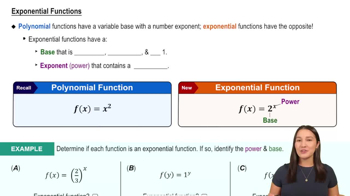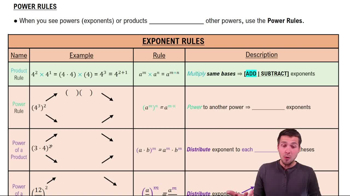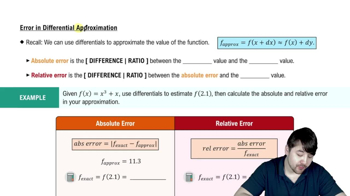Table of contents
- 0. Functions7h 52m
- Introduction to Functions16m
- Piecewise Functions10m
- Properties of Functions9m
- Common Functions1h 8m
- Transformations5m
- Combining Functions27m
- Exponent rules32m
- Exponential Functions28m
- Logarithmic Functions24m
- Properties of Logarithms34m
- Exponential & Logarithmic Equations35m
- Introduction to Trigonometric Functions38m
- Graphs of Trigonometric Functions44m
- Trigonometric Identities47m
- Inverse Trigonometric Functions48m
- 1. Limits and Continuity2h 2m
- 2. Intro to Derivatives1h 33m
- 3. Techniques of Differentiation3h 18m
- 4. Applications of Derivatives2h 38m
- 5. Graphical Applications of Derivatives6h 2m
- 6. Derivatives of Inverse, Exponential, & Logarithmic Functions2h 37m
- 7. Antiderivatives & Indefinite Integrals1h 26m
- 8. Definite Integrals4h 44m
- 9. Graphical Applications of Integrals2h 27m
- 10. Physics Applications of Integrals 2h 22m
4. Applications of Derivatives
Differentials
Problem 4.7.75
Textbook Question
17–83. Limits Evaluate the following limits. Use l’Hôpital’s Rule when it is convenient and applicable.
lim_x→0⁺ x²ˣ
 Verified step by step guidance
Verified step by step guidance1
Identify the form of the limit as x approaches 0 from the positive side. The expression x²ˣ can be rewritten as e^(x ln(x²)). As x approaches 0⁺, x ln(x²) approaches an indeterminate form 0 * (-∞).
Rewrite the expression x²ˣ as e^(2x ln(x)). This helps in applying the limit to the exponent first, which is 2x ln(x).
Consider the limit of the exponent: lim_(x→0⁺) 2x ln(x). This is an indeterminate form of type 0 * (-∞), which can be rewritten as lim_(x→0⁺) (ln(x) / (1/(2x))).
Apply l'Hôpital's Rule to the limit of the exponent, since it is in the indeterminate form ∞/∞. Differentiate the numerator and the denominator separately: the derivative of ln(x) is 1/x, and the derivative of 1/(2x) is -1/(2x²).
Evaluate the new limit after applying l'Hôpital's Rule: lim_(x→0⁺) (1/x) / (-1/(2x²)) simplifies to lim_(x→0⁺) -2x. As x approaches 0⁺, this limit approaches 0. Therefore, the original limit of x²ˣ is e^0, which simplifies to 1.
 Verified video answer for a similar problem:
Verified video answer for a similar problem:This video solution was recommended by our tutors as helpful for the problem above
Video duration:
11mPlay a video:
Was this helpful?
Key Concepts
Here are the essential concepts you must grasp in order to answer the question correctly.
Limits
Limits are fundamental concepts in calculus that describe the behavior of a function as its input approaches a certain value. They help in understanding the function's behavior near points of interest, including points of discontinuity or infinity. Evaluating limits is essential for defining derivatives and integrals, which are core components of calculus.
Recommended video:

One-Sided Limits
Exponential Functions
Exponential functions are mathematical functions of the form f(x) = a^x, where 'a' is a positive constant. In the context of the limit lim_x→0⁺ x²ˣ, the expression involves an exponential function with a variable base. Understanding the properties of exponential functions, especially their behavior as the exponent approaches zero, is crucial for evaluating this limit.
Recommended video:

Exponential Functions
l'Hôpital's Rule
l'Hôpital's Rule is a method used to evaluate limits that result in indeterminate forms, such as 0/0 or ∞/∞. It states that if the limit of f(x)/g(x) leads to an indeterminate form, the limit can be found by taking the derivative of the numerator and the derivative of the denominator. This rule simplifies the process of finding limits, especially when direct substitution is not possible.
Recommended video:
Guided course

Power Rules







